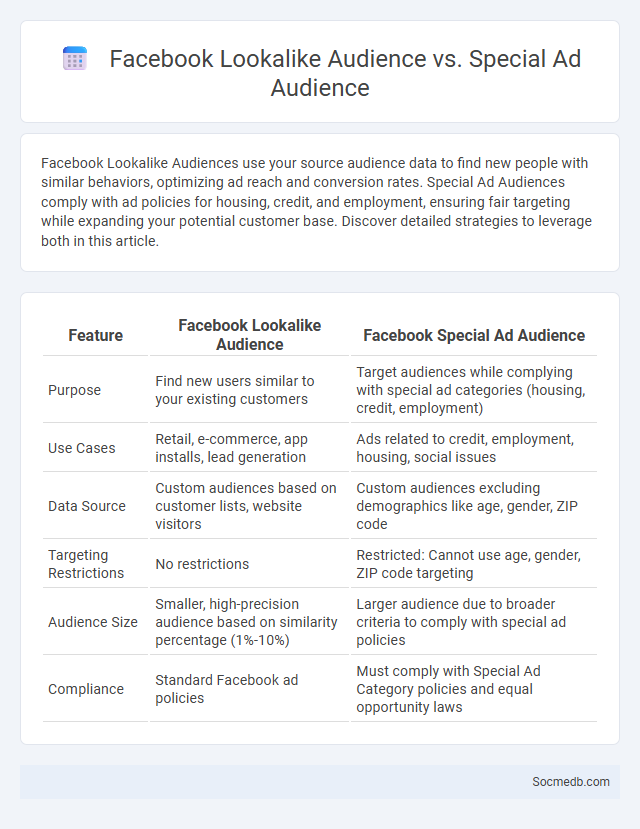
Photo illustration: Facebook Lookalike Audience vs Special Ad Audience
Facebook Lookalike Audiences use your source audience data to find new people with similar behaviors, optimizing ad reach and conversion rates. Special Ad Audiences comply with ad policies for housing, credit, and employment, ensuring fair targeting while expanding your potential customer base. Discover detailed strategies to leverage both in this article.
Table of Comparison
| Feature | Facebook Lookalike Audience | Facebook Special Ad Audience |
|---|---|---|
| Purpose | Find new users similar to your existing customers | Target audiences while complying with special ad categories (housing, credit, employment) |
| Use Cases | Retail, e-commerce, app installs, lead generation | Ads related to credit, employment, housing, social issues |
| Data Source | Custom audiences based on customer lists, website visitors | Custom audiences excluding demographics like age, gender, ZIP code |
| Targeting Restrictions | No restrictions | Restricted: Cannot use age, gender, ZIP code targeting |
| Audience Size | Smaller, high-precision audience based on similarity percentage (1%-10%) | Larger audience due to broader criteria to comply with special ad policies |
| Compliance | Standard Facebook ad policies | Must comply with Special Ad Category policies and equal opportunity laws |
Introduction to Facebook Audience Targeting
Facebook Audience Targeting allows you to precisely reach potential customers based on demographics, interests, and behaviors. Leveraging tools like Custom Audiences and Lookalike Audiences helps refine your campaigns for higher engagement and conversion rates. Understanding your audience's preferences and online habits maximizes your ad spend efficiency and results.
What is a Facebook Lookalike Audience?
A Facebook Lookalike Audience is a powerful advertising tool that helps you reach new people who share similar characteristics with your existing customers or followers. By analyzing data from a source audience, Facebook's algorithm identifies common traits such as demographics, interests, and behaviors to create a new audience likely to engage with your content. Your marketing efforts become more efficient by targeting individuals with higher potential for conversion.
Overview of Facebook Special Ad Audience
Facebook Special Ad Audience is a tailored advertising feature designed to help marketers reach specific groups while complying with anti-discrimination policies. This tool excludes certain targeting options like age, gender, and ZIP code to ensure fair housing, credit, and employment ads. By leveraging behavioral and interest-based data, advertisers can effectively connect with relevant users without violating regulatory requirements.
Key Differences: Lookalike Audience vs Special Ad Audience
Lookalike Audience targets users similar to your existing customers based on data from your source audience, enhancing ad reach with high relevance and potential conversions. Special Ad Audience is designed specifically for ads related to housing, employment, or credit, complying with platform policies by limiting demographic targeting options to prevent discrimination. Your campaign's success depends on choosing Lookalike Audiences for broader growth and Special Ad Audiences when advertising restricted categories within regulatory constraints.
Benefits of Using Lookalike Audiences
Lookalike Audiences help you expand your reach by targeting users who closely resemble your existing customers, increasing the likelihood of engagement and conversions. This advanced targeting method leverages data patterns to find new, high-quality prospects on social media platforms, optimizing your ad spend efficiency. By using Lookalike Audiences, your campaigns experience improved relevance and personalization, driving better ROI and growing your brand presence effectively.
Advantages of Special Ad Audiences
Special Ad Audiences on social media help you precisely target users similar to your existing customers by leveraging platform algorithms and data insights. These audiences improve ad relevance and increase conversion rates by focusing on user behavior and engagement patterns. Utilizing Special Ad Audiences enhances your ad campaign efficiency while adhering to advertising policies that restrict certain targeting options.
Limitations and Restrictions of Each Audience Type
Social media platforms impose specific limitations and restrictions based on audience types such as age, location, and user preferences, affecting content visibility and interaction capabilities. Younger audiences often face stricter privacy controls and content filters, while professional networks limit conversational tone and personal content to maintain formality. Your ability to engage effectively depends on understanding these audience-specific guidelines to optimize reach and compliance.
Best Use Cases for Lookalike Audiences
Lookalike audiences excel in social media advertising by enabling businesses to target new potential customers who share characteristics with their existing high-value users, leading to higher conversion rates. E-commerce brands benefit significantly by expanding reach to users likely to purchase based on similarities to previous buyers, while B2B companies use lookalike audiences to identify prospects matching ideal client profiles from their CRM data. Campaigns focusing on event promotion and app installs also see improved efficiency through lookalike targeting, as ads reach individuals with behaviors aligned with previous successful attendees or active users.
When to Choose Special Ad Audiences
Special Ad Audiences are essential when targeting sensitive categories like housing, employment, or credit ads to comply with Facebook's non-discrimination policies. Choosing Special Ad Audiences helps advertisers reach relevant users while adhering to restrictions on attributes like age, gender, and ZIP code. This approach ensures optimized targeting without violating platform rules, maximizing ad performance in regulated industries.
Conclusion: Selecting the Right Facebook Audience for Your Campaign
Selecting the right Facebook audience for your campaign directly impacts ad performance, engagement rates, and return on investment. Utilizing Facebook's robust targeting options such as demographics, interests, behaviors, and custom audiences allows you to reach users who are most likely to convert. By focusing on precise audience segmentation, you maximize your campaign's effectiveness and ensure your marketing budget delivers optimal results.
 socmedb.com
socmedb.com